An Analysis of PC Financial's Global Strategy in Canadian Banking
VerifiedAdded on 2023/06/12
|6
|1307
|208
Report
AI Summary
This report provides an analysis of PC Financial's global strategy within the Canadian banking industry. It highlights the characteristics of the Canadian banking system, emphasizing its safety and regulation. The report details PC Financial's approach, including its digital brand, online banking services, and continuous innovation in products and services. It also explores the competitive strategies employed by PC Financial, such as differentiating its products, standardizing services, and leveraging mobile banking. The analysis concludes by suggesting future moves for PC Financial, focusing on differentiation, standardization, and intellectual property to enhance its competitive edge and profitability. Desklib provides students access to similar reports and solved assignments for academic assistance.
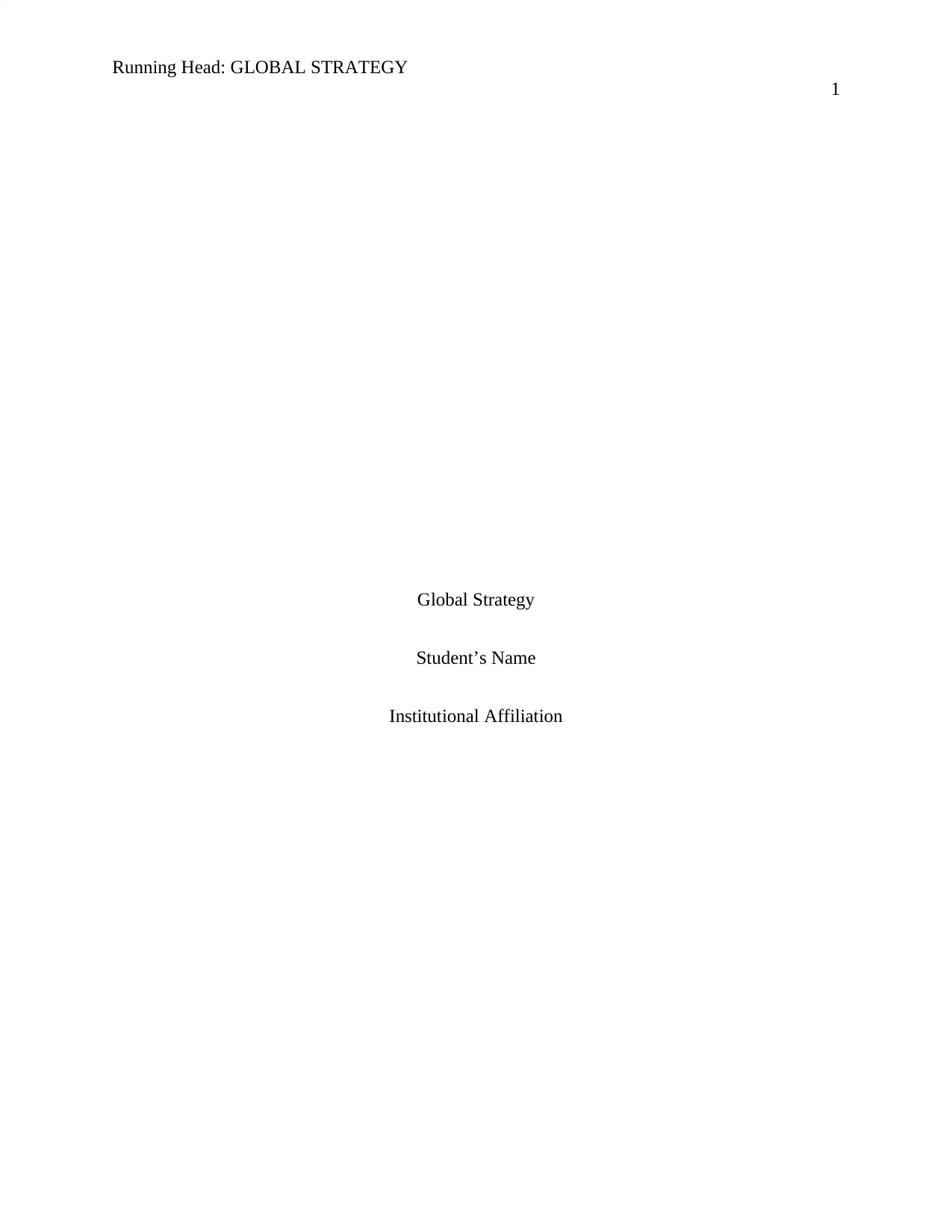
Running Head: GLOBAL STRATEGY
1
Global Strategy
Student’s Name
Institutional Affiliation
1
Global Strategy
Student’s Name
Institutional Affiliation
Paraphrase This Document
Need a fresh take? Get an instant paraphrase of this document with our AI Paraphraser
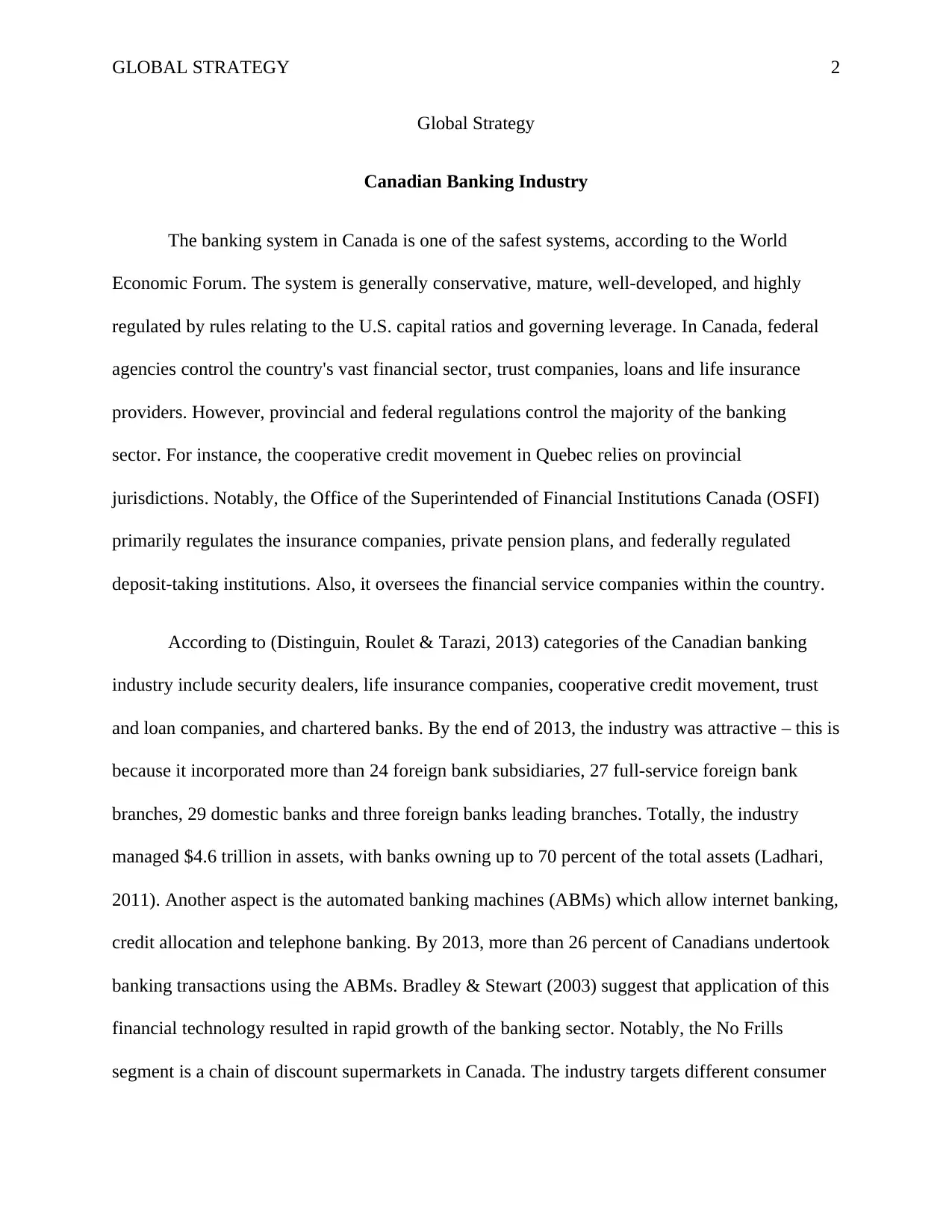
GLOBAL STRATEGY 2
Global Strategy
Canadian Banking Industry
The banking system in Canada is one of the safest systems, according to the World
Economic Forum. The system is generally conservative, mature, well-developed, and highly
regulated by rules relating to the U.S. capital ratios and governing leverage. In Canada, federal
agencies control the country's vast financial sector, trust companies, loans and life insurance
providers. However, provincial and federal regulations control the majority of the banking
sector. For instance, the cooperative credit movement in Quebec relies on provincial
jurisdictions. Notably, the Office of the Superintended of Financial Institutions Canada (OSFI)
primarily regulates the insurance companies, private pension plans, and federally regulated
deposit-taking institutions. Also, it oversees the financial service companies within the country.
According to (Distinguin, Roulet & Tarazi, 2013) categories of the Canadian banking
industry include security dealers, life insurance companies, cooperative credit movement, trust
and loan companies, and chartered banks. By the end of 2013, the industry was attractive – this is
because it incorporated more than 24 foreign bank subsidiaries, 27 full-service foreign bank
branches, 29 domestic banks and three foreign banks leading branches. Totally, the industry
managed $4.6 trillion in assets, with banks owning up to 70 percent of the total assets (Ladhari,
2011). Another aspect is the automated banking machines (ABMs) which allow internet banking,
credit allocation and telephone banking. By 2013, more than 26 percent of Canadians undertook
banking transactions using the ABMs. Bradley & Stewart (2003) suggest that application of this
financial technology resulted in rapid growth of the banking sector. Notably, the No Frills
segment is a chain of discount supermarkets in Canada. The industry targets different consumer
Global Strategy
Canadian Banking Industry
The banking system in Canada is one of the safest systems, according to the World
Economic Forum. The system is generally conservative, mature, well-developed, and highly
regulated by rules relating to the U.S. capital ratios and governing leverage. In Canada, federal
agencies control the country's vast financial sector, trust companies, loans and life insurance
providers. However, provincial and federal regulations control the majority of the banking
sector. For instance, the cooperative credit movement in Quebec relies on provincial
jurisdictions. Notably, the Office of the Superintended of Financial Institutions Canada (OSFI)
primarily regulates the insurance companies, private pension plans, and federally regulated
deposit-taking institutions. Also, it oversees the financial service companies within the country.
According to (Distinguin, Roulet & Tarazi, 2013) categories of the Canadian banking
industry include security dealers, life insurance companies, cooperative credit movement, trust
and loan companies, and chartered banks. By the end of 2013, the industry was attractive – this is
because it incorporated more than 24 foreign bank subsidiaries, 27 full-service foreign bank
branches, 29 domestic banks and three foreign banks leading branches. Totally, the industry
managed $4.6 trillion in assets, with banks owning up to 70 percent of the total assets (Ladhari,
2011). Another aspect is the automated banking machines (ABMs) which allow internet banking,
credit allocation and telephone banking. By 2013, more than 26 percent of Canadians undertook
banking transactions using the ABMs. Bradley & Stewart (2003) suggest that application of this
financial technology resulted in rapid growth of the banking sector. Notably, the No Frills
segment is a chain of discount supermarkets in Canada. The industry targets different consumer
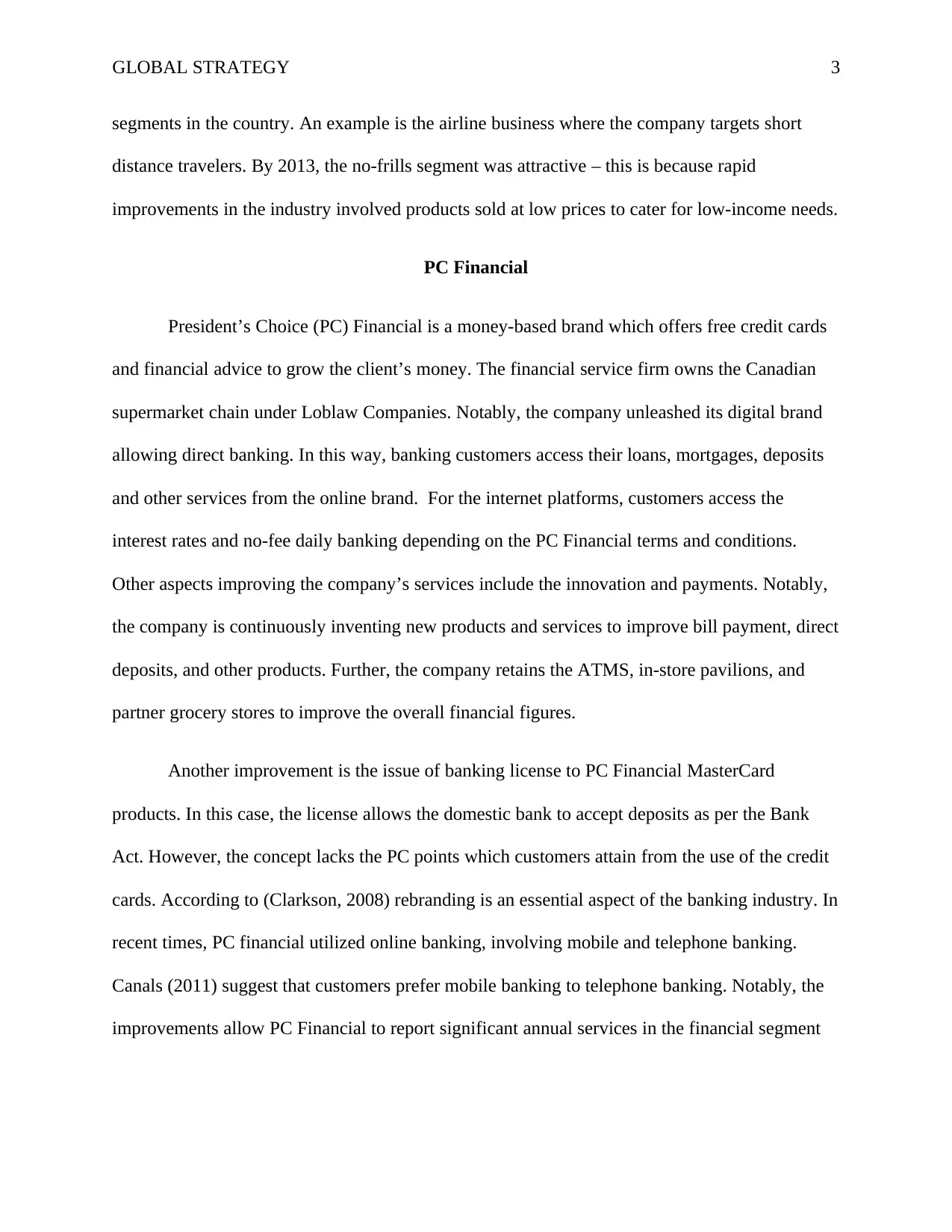
GLOBAL STRATEGY 3
segments in the country. An example is the airline business where the company targets short
distance travelers. By 2013, the no-frills segment was attractive – this is because rapid
improvements in the industry involved products sold at low prices to cater for low-income needs.
PC Financial
President’s Choice (PC) Financial is a money-based brand which offers free credit cards
and financial advice to grow the client’s money. The financial service firm owns the Canadian
supermarket chain under Loblaw Companies. Notably, the company unleashed its digital brand
allowing direct banking. In this way, banking customers access their loans, mortgages, deposits
and other services from the online brand. For the internet platforms, customers access the
interest rates and no-fee daily banking depending on the PC Financial terms and conditions.
Other aspects improving the company’s services include the innovation and payments. Notably,
the company is continuously inventing new products and services to improve bill payment, direct
deposits, and other products. Further, the company retains the ATMS, in-store pavilions, and
partner grocery stores to improve the overall financial figures.
Another improvement is the issue of banking license to PC Financial MasterCard
products. In this case, the license allows the domestic bank to accept deposits as per the Bank
Act. However, the concept lacks the PC points which customers attain from the use of the credit
cards. According to (Clarkson, 2008) rebranding is an essential aspect of the banking industry. In
recent times, PC financial utilized online banking, involving mobile and telephone banking.
Canals (2011) suggest that customers prefer mobile banking to telephone banking. Notably, the
improvements allow PC Financial to report significant annual services in the financial segment
segments in the country. An example is the airline business where the company targets short
distance travelers. By 2013, the no-frills segment was attractive – this is because rapid
improvements in the industry involved products sold at low prices to cater for low-income needs.
PC Financial
President’s Choice (PC) Financial is a money-based brand which offers free credit cards
and financial advice to grow the client’s money. The financial service firm owns the Canadian
supermarket chain under Loblaw Companies. Notably, the company unleashed its digital brand
allowing direct banking. In this way, banking customers access their loans, mortgages, deposits
and other services from the online brand. For the internet platforms, customers access the
interest rates and no-fee daily banking depending on the PC Financial terms and conditions.
Other aspects improving the company’s services include the innovation and payments. Notably,
the company is continuously inventing new products and services to improve bill payment, direct
deposits, and other products. Further, the company retains the ATMS, in-store pavilions, and
partner grocery stores to improve the overall financial figures.
Another improvement is the issue of banking license to PC Financial MasterCard
products. In this case, the license allows the domestic bank to accept deposits as per the Bank
Act. However, the concept lacks the PC points which customers attain from the use of the credit
cards. According to (Clarkson, 2008) rebranding is an essential aspect of the banking industry. In
recent times, PC financial utilized online banking, involving mobile and telephone banking.
Canals (2011) suggest that customers prefer mobile banking to telephone banking. Notably, the
improvements allow PC Financial to report significant annual services in the financial segment
⊘ This is a preview!⊘
Do you want full access?
Subscribe today to unlock all pages.

Trusted by 1+ million students worldwide
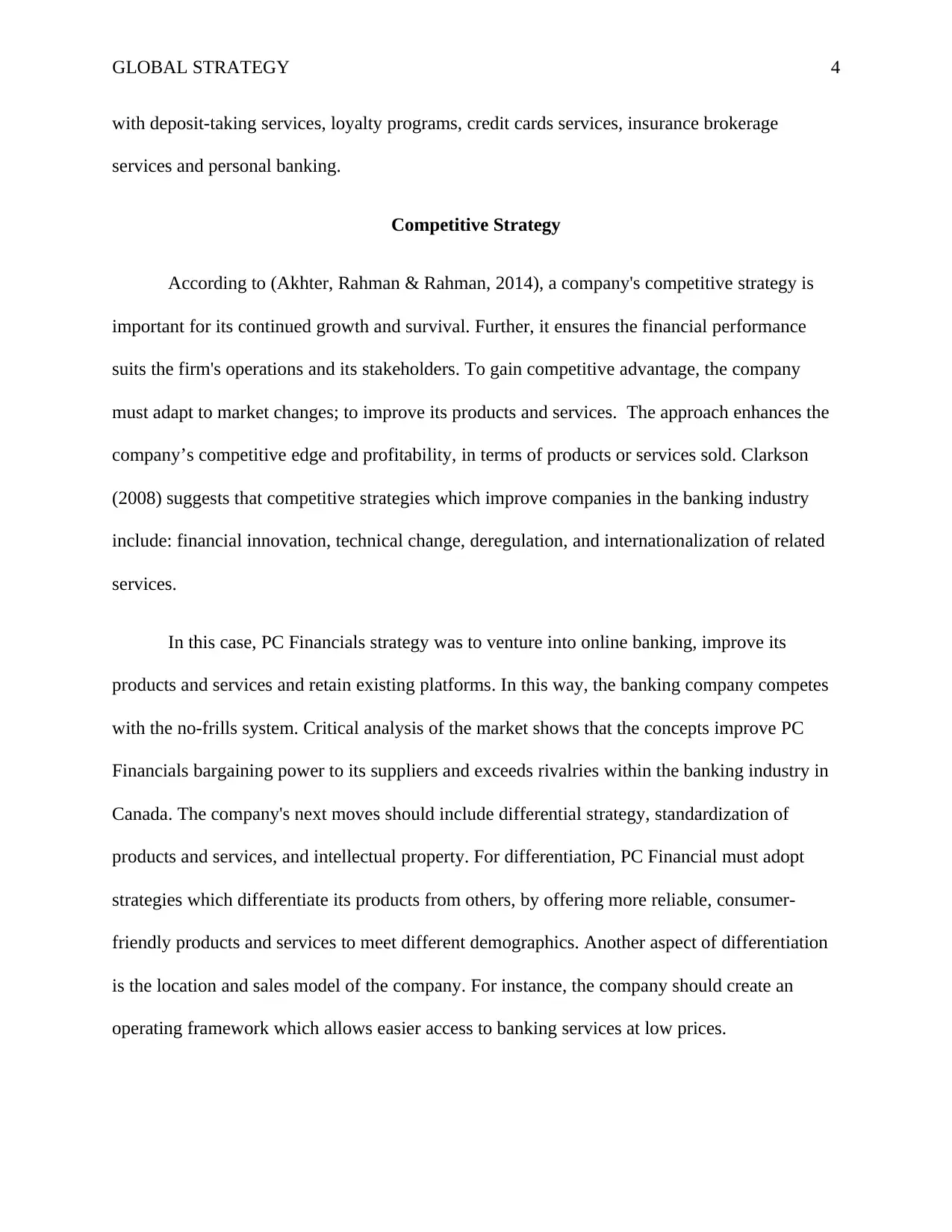
GLOBAL STRATEGY 4
with deposit-taking services, loyalty programs, credit cards services, insurance brokerage
services and personal banking.
Competitive Strategy
According to (Akhter, Rahman & Rahman, 2014), a company's competitive strategy is
important for its continued growth and survival. Further, it ensures the financial performance
suits the firm's operations and its stakeholders. To gain competitive advantage, the company
must adapt to market changes; to improve its products and services. The approach enhances the
company’s competitive edge and profitability, in terms of products or services sold. Clarkson
(2008) suggests that competitive strategies which improve companies in the banking industry
include: financial innovation, technical change, deregulation, and internationalization of related
services.
In this case, PC Financials strategy was to venture into online banking, improve its
products and services and retain existing platforms. In this way, the banking company competes
with the no-frills system. Critical analysis of the market shows that the concepts improve PC
Financials bargaining power to its suppliers and exceeds rivalries within the banking industry in
Canada. The company's next moves should include differential strategy, standardization of
products and services, and intellectual property. For differentiation, PC Financial must adopt
strategies which differentiate its products from others, by offering more reliable, consumer-
friendly products and services to meet different demographics. Another aspect of differentiation
is the location and sales model of the company. For instance, the company should create an
operating framework which allows easier access to banking services at low prices.
with deposit-taking services, loyalty programs, credit cards services, insurance brokerage
services and personal banking.
Competitive Strategy
According to (Akhter, Rahman & Rahman, 2014), a company's competitive strategy is
important for its continued growth and survival. Further, it ensures the financial performance
suits the firm's operations and its stakeholders. To gain competitive advantage, the company
must adapt to market changes; to improve its products and services. The approach enhances the
company’s competitive edge and profitability, in terms of products or services sold. Clarkson
(2008) suggests that competitive strategies which improve companies in the banking industry
include: financial innovation, technical change, deregulation, and internationalization of related
services.
In this case, PC Financials strategy was to venture into online banking, improve its
products and services and retain existing platforms. In this way, the banking company competes
with the no-frills system. Critical analysis of the market shows that the concepts improve PC
Financials bargaining power to its suppliers and exceeds rivalries within the banking industry in
Canada. The company's next moves should include differential strategy, standardization of
products and services, and intellectual property. For differentiation, PC Financial must adopt
strategies which differentiate its products from others, by offering more reliable, consumer-
friendly products and services to meet different demographics. Another aspect of differentiation
is the location and sales model of the company. For instance, the company should create an
operating framework which allows easier access to banking services at low prices.
Paraphrase This Document
Need a fresh take? Get an instant paraphrase of this document with our AI Paraphraser
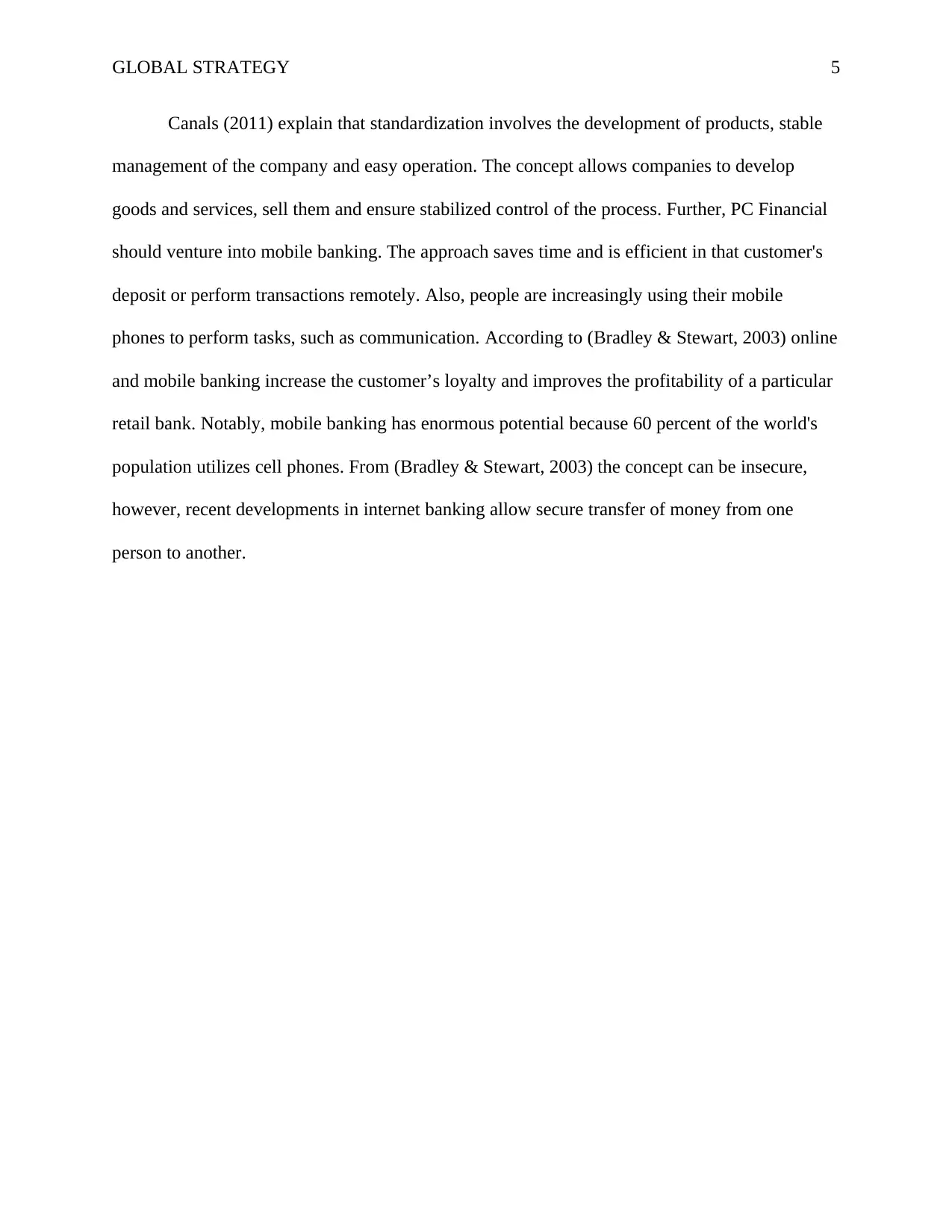
GLOBAL STRATEGY 5
Canals (2011) explain that standardization involves the development of products, stable
management of the company and easy operation. The concept allows companies to develop
goods and services, sell them and ensure stabilized control of the process. Further, PC Financial
should venture into mobile banking. The approach saves time and is efficient in that customer's
deposit or perform transactions remotely. Also, people are increasingly using their mobile
phones to perform tasks, such as communication. According to (Bradley & Stewart, 2003) online
and mobile banking increase the customer’s loyalty and improves the profitability of a particular
retail bank. Notably, mobile banking has enormous potential because 60 percent of the world's
population utilizes cell phones. From (Bradley & Stewart, 2003) the concept can be insecure,
however, recent developments in internet banking allow secure transfer of money from one
person to another.
Canals (2011) explain that standardization involves the development of products, stable
management of the company and easy operation. The concept allows companies to develop
goods and services, sell them and ensure stabilized control of the process. Further, PC Financial
should venture into mobile banking. The approach saves time and is efficient in that customer's
deposit or perform transactions remotely. Also, people are increasingly using their mobile
phones to perform tasks, such as communication. According to (Bradley & Stewart, 2003) online
and mobile banking increase the customer’s loyalty and improves the profitability of a particular
retail bank. Notably, mobile banking has enormous potential because 60 percent of the world's
population utilizes cell phones. From (Bradley & Stewart, 2003) the concept can be insecure,
however, recent developments in internet banking allow secure transfer of money from one
person to another.
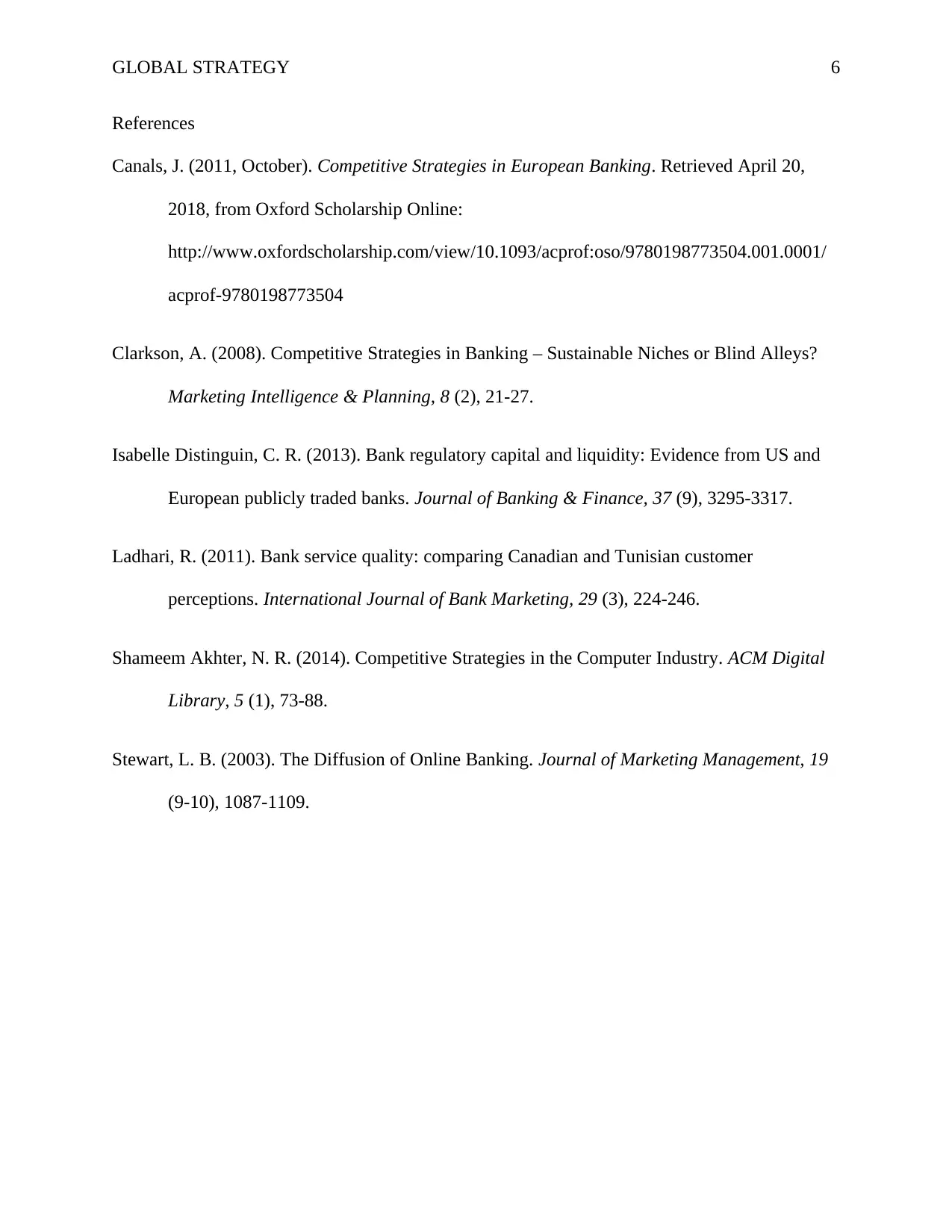
GLOBAL STRATEGY 6
References
Canals, J. (2011, October). Competitive Strategies in European Banking. Retrieved April 20,
2018, from Oxford Scholarship Online:
http://www.oxfordscholarship.com/view/10.1093/acprof:oso/9780198773504.001.0001/
acprof-9780198773504
Clarkson, A. (2008). Competitive Strategies in Banking – Sustainable Niches or Blind Alleys?
Marketing Intelligence & Planning, 8 (2), 21-27.
Isabelle Distinguin, C. R. (2013). Bank regulatory capital and liquidity: Evidence from US and
European publicly traded banks. Journal of Banking & Finance, 37 (9), 3295-3317.
Ladhari, R. (2011). Bank service quality: comparing Canadian and Tunisian customer
perceptions. International Journal of Bank Marketing, 29 (3), 224-246.
Shameem Akhter, N. R. (2014). Competitive Strategies in the Computer Industry. ACM Digital
Library, 5 (1), 73-88.
Stewart, L. B. (2003). The Diffusion of Online Banking. Journal of Marketing Management, 19
(9-10), 1087-1109.
References
Canals, J. (2011, October). Competitive Strategies in European Banking. Retrieved April 20,
2018, from Oxford Scholarship Online:
http://www.oxfordscholarship.com/view/10.1093/acprof:oso/9780198773504.001.0001/
acprof-9780198773504
Clarkson, A. (2008). Competitive Strategies in Banking – Sustainable Niches or Blind Alleys?
Marketing Intelligence & Planning, 8 (2), 21-27.
Isabelle Distinguin, C. R. (2013). Bank regulatory capital and liquidity: Evidence from US and
European publicly traded banks. Journal of Banking & Finance, 37 (9), 3295-3317.
Ladhari, R. (2011). Bank service quality: comparing Canadian and Tunisian customer
perceptions. International Journal of Bank Marketing, 29 (3), 224-246.
Shameem Akhter, N. R. (2014). Competitive Strategies in the Computer Industry. ACM Digital
Library, 5 (1), 73-88.
Stewart, L. B. (2003). The Diffusion of Online Banking. Journal of Marketing Management, 19
(9-10), 1087-1109.
⊘ This is a preview!⊘
Do you want full access?
Subscribe today to unlock all pages.

Trusted by 1+ million students worldwide
1 out of 6
Related Documents
Your All-in-One AI-Powered Toolkit for Academic Success.
+13062052269
info@desklib.com
Available 24*7 on WhatsApp / Email
![[object Object]](/_next/static/media/star-bottom.7253800d.svg)
Unlock your academic potential
Copyright © 2020–2025 A2Z Services. All Rights Reserved. Developed and managed by ZUCOL.





